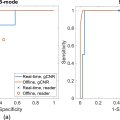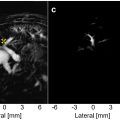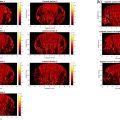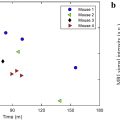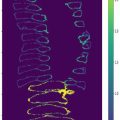Abstract
Objective
The response of ultrasound contrast agents is sensitive to ambient pressure, especially via their scattered subharmonic signal, which makes them a promising candidate for non-invasive pressure measurements in vivo . This work aimed to understand the sensitivity to ambient pressure of subharmonic oscillations from single microbubbles.
Methods
The subharmonic oscillation amplitude of single microbubbles in response to varying ambient pressure was studied both experimentally and numerically. In experiment, approximately 2200 single microbubbles from a monodisperse population were measured at a driving frequency close to twice their resonance frequency.
Results
The results of the numerical simulations and experiments show that a pressure change leads to a small size change in the bubble that then changes the lipid packing density, and with that the stiffness of the bubble shell.
Conclusion
The dependency of subharmonic oscillation amplitude to changes in ambient pressure can be explained by a shift in the resonance frequency of the bubble as a function of ambient pressure. The subharmonic response increases with ambient pressure when the resonance frequency shifts toward half the driving frequency and decreases when the resonance frequency shifts away from half the driving frequency. These findings help to understand non-invasive pressure sensing through subharmonic ultrasound imaging.
Introduction
From the early days of ultrasound contrast agents, it has been known that the acoustic behavior of microbubbles depends on the ambient pressure, i.e. , the semi-static surrounding pressure a bubble is experiencing. Therefore, microbubbles can, in principle, be used to measure changes in ambient pressure, e.g. , for the non-invasive measurement of blood pressure. Blood pressure measurement using contrast-enhanced ultrasound was first suggested by Tickner [ ], where the resonance frequency of a bubble was directly related to its size at the corresponding ambient pressure. A different idea was proposed by Bouakaz et al. [ ], who aimed to fracture bubbles with a rigid coating and subsequently envisioned using the dissolution rate of the released free gas bubble to measure the ambient pressure. Another idea, which did not specifically require bubble destruction, was proposed by Shi et al. [ ], who reasoned that the subharmonic scattering amplitude, i.e. , at a harmonic below the driving frequency, could be used to estimate ambient pressure.
Recently, subharmonic sensitivity to ambient pressure has garnered more attention through the Subharmonic Aided Pressure Estimation (SHAPE) technique [ ], which is also the subject of a clinical trial (NCT05470205). Studies employing SHAPE have identified an occurrence, growth and saturation stage for subharmonic scattering as a function of ambient pressure and used the linear growth stage to semi-qualitatively measure blood pressure. However, the mechanisms underlying SHAPE are not fully understood. There is little consensus on the dependency of the subharmonic signal to ambient pressure, i.e. , the change (and direction of change) in subharmonic scattered signal as a function of ambient pressure, even for well-controlled in vitro studies using the same contrast agents [ ]. Subharmonic scattering can decrease or increase with ambient pressure increases, and this sensitivity is found to also depend on acoustic pressure amplitude, frequency, as well as on the initial ambient pressure [ , ].
Free gas bubbles start oscillating at subharmonic frequencies when they are driven at sufficiently large vibrational amplitudes [ ] irrespective of the driving frequency [ , ]. These higher oscillation-amplitude subharmonics are often employed as an indicator for the onset of inertial cavitation [ ]. A numerical investigation by Katiyar et al. [ ] into the ambient pressure sensitivity of free gas bubble subharmonics (and simple encapsulated microbubbles) under high driving pressures identified a resonance effect explaining the subharmonic response to ambient pressure. A critical ratio of approximately 1.6 between driving frequency and microbubble resonance frequency at ambient pressure was found, for which the subharmonics reached a maximum. Below this ratio (1.4–1.6), subharmonic amplitude generally increased with additional ambient pressure due to the corresponding rise in natural frequency. Conversely, for ratios above 2.1, subharmonics were found to decrease [ ]. However, their model (based on the BUBBLESIM simulation code [ ]) did not account for shell buckling and rupture, leaving the ambient pressure sensitivity of subharmonics at low acoustic pressure for lipid-coated agents, such as SonoVue, unexplained [ ].
Lipid-coated microbubbles experience a sudden change in shell elasticity upon buckling, resulting in a much lower vibrational amplitude threshold for subharmonic generation [ , ]. The abrupt change in shell elasticity introduces a stronger and more complex relationship between resonance frequency and ambient pressure [ , ]. The generation of subharmonics at lower vibrational amplitudes is of interest due to the reduced risk of acoustic deflation [ ], offering greater potential for repeatable subharmonic versus ambient pressure behavior. Studies employing low acoustic-amplitude subharmonics often report increasing subharmonics with rising hydrostatic pressure, which is attributed to microbubbles that are close to buckling ( i.e. , those with low initial surface tension) [ , ]. However, other studies have shown that subharmonic scattering at a fixed acoustic pressure amplitude can increase or decrease by adjusting the ultrasound driving frequency [ ], suggesting resonance frequency dependence similar to that observed for high oscillation amplitude-driven subharmonics [ ]. Typical in vitro subharmonic pressure sensitivity studies employ pulse-echo to measure (bulk) subharmonic scattering of an ensemble of microbubble sizes, which provides limited information on single bubble dynamics. Faez et al. [ ] managed to measure subharmonic scattering while applying a dynamic ambient pressure. This study showed that in a batch of polydisperse microbubbles, subharmonic scattering can indeed change with ambient pressure, and the preferential dependency of the subharmonic response on ambient pressure changes with driving frequency. However, deducing the exact mechanism responsible for this shift was difficult as bubble sizes were not known.
Here, we used a narrow size distribution of microbubbles that provided a starting point to model and understand the subharmonic oscillation behavior in response to pressure change. We utilized the acoustic camera approach of Renaud et al. [ ], which then allowed acoustic characterization of freely oscillating, single microbubbles. We focused primarily on subharmonics at low-oscillation amplitudes, as these can be experimentally verified using the acoustic camera, but for completeness sake, subharmonics at higher oscillation amplitudes were treated separately numerically in Appendix C . In this study, we use the acoustic camera in conjunction with numerical simulations to unravel the mechanisms underlying the ambient pressure sensitivity of subharmonic microbubble vibrations.
Theory
The dynamics of a lipid-coated microbubble to an acoustic pulse are commonly modeled with the Marmottant model [ ], which is based on a Rayleigh Plesset-type equation and accounts for the viscoelastic properties of a lipid-shelled microbubble, including buckling and rupture mechanics (eqn [ ]):
ρ(R¨R+32R˙2)=(P0+2σ(R0)R0)(R0R)3κ−4μLR˙R−Pamb−Pa(t)−2χR(R2R0−1)−4κsR˙R2.
Here, R is the instantaneous bubble radius with its time derivatives denoted by overdots, and the initial radius is R 0 . P a is the acoustic driving pressure and P amb the ambient pressure. μ L is the viscosity of the liquid surrounding the microbubble and the liquid density is ρ. κ is the polytropic exponent of the gas in the core.
The lipid shell protects the bubble against dissolution by lowering the initial surface tension σ ( R 0 ). Additionally, the viscoelastic shell adds a shell viscosity k s and a surface elasticity χ , where χ is defined as the derivative of the size-dependent surface tension σ( R ) with respect to the microbubble surface area, A: χ=Adσ(R)dA
χ = A d σ ( R ) d A
. To account for the buckling and rupture mechanics of the shell, σ( R ) is a piecewise function of R given by eqn (2) :
with σ w the surface tension of water. Eqn (2) shows that the surface elasticity is only non-zero in the elastic regime bounded by the buckling radius R b and rupture radius R r . This elastic regime is limited to a few percent of the initial radius, depending on χ .
As a result of the buckling and rupture mechanics, the effective surface elasticity experienced by the system depends on the microbubble oscillation amplitude [ ] as well as on minor size changes such as those imposed by static pressure changes [ , ]; i.e. , it depends on driving and ambient pressure, respectively. As microbubble oscillation amplitudes used in imaging typically extend beyond the elastic regime, it is useful to consider an effective stiffness, χ eff , which is the χ averaged over (part of) the microbubble response (eqn [ ]) [ ]:
where t 1 and t 2 are arbitrary time points. A change in χ eff results in a change in the effective resonance frequency f 0, eff of the system. f 0, eff follows from a linearization of eqn (1) [ ]:
Eqn (4) shows an explicit ( P amb ) and implicit ( R 0 , σ ( R 0 ) and χ eff ) dependency on P amb , with χ eff potentially outweighing the other terms by two orders of magnitude [ ].
The amplitude dependency of f 0, eff has found widespread use in ultrasound imaging, for example through amplitude modulation [ ]. While the P amb dependency of f 0, eff and its effect on fundamental scattering has previously been investigated [ ], here we investigated the P amb dependency of f 0, eff and its effect on the subharmonic response, starting with numerical simulations.
Numerical methods
Simulated microbubble responses were generated by solving eqn (10), as described in [ ]. The medium and shell parameters used in the simulations are listed in Table 1 . The base P amb ,0 was set to 104 kPa to match the hydrostatic pressure experienced by the microbubbles in the experimental setup and liquid viscosity was doubled to account for thermal damping [ ]. Non-physical transitions of surface elasticity at the buckling and rupture points were avoided by using the smoothing boundary function, as described in [ ], with a smoothing value of 5000 N/m.
| Property | Symbol | Value | Unit |
|---|---|---|---|
| Stiffness | χ | 0.65 | N/m |
| Shell viscosity | κ s | 1e-9 | kg/s |
| Density | ρ | 1000 | kg/m 3 |
| Ambient pressure | P amb ,0 | 104 | kPa |
| Polytropic index | κ | 1.07 | [-] |
| Speed of sound | C | 1483 | m/s |
| Liquid viscosity | μ L | 2 × 1e-3 | Pa/s |
Stay updated, free articles. Join our Telegram channel

Full access? Get Clinical Tree



